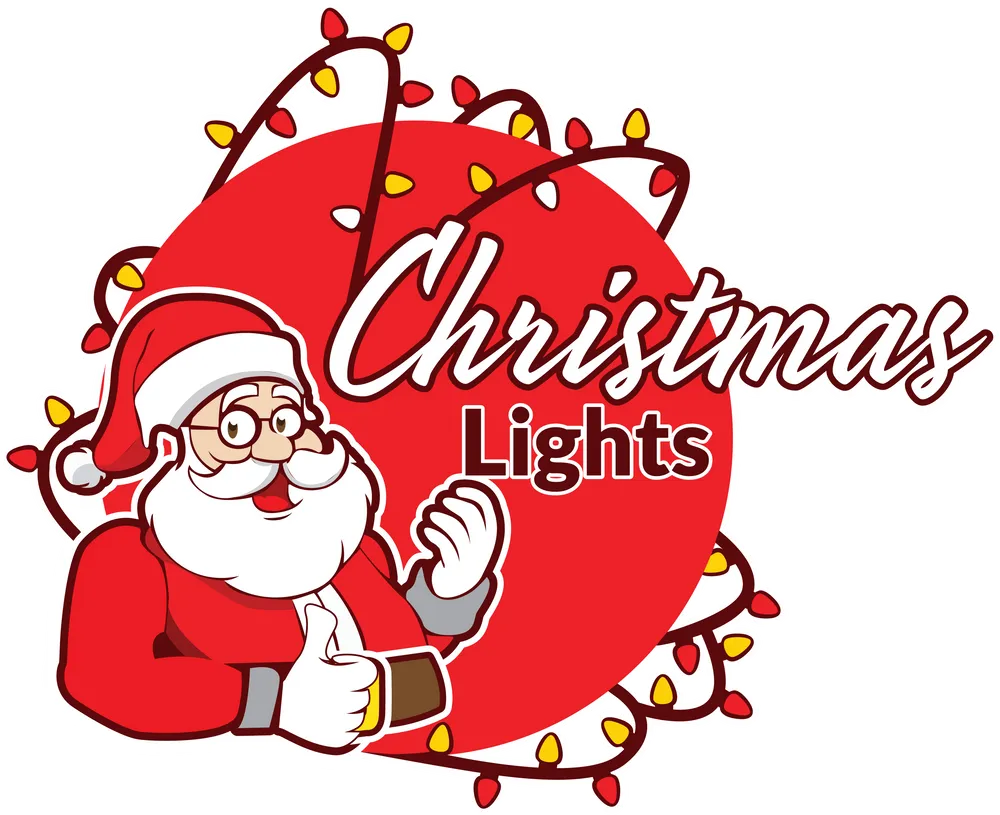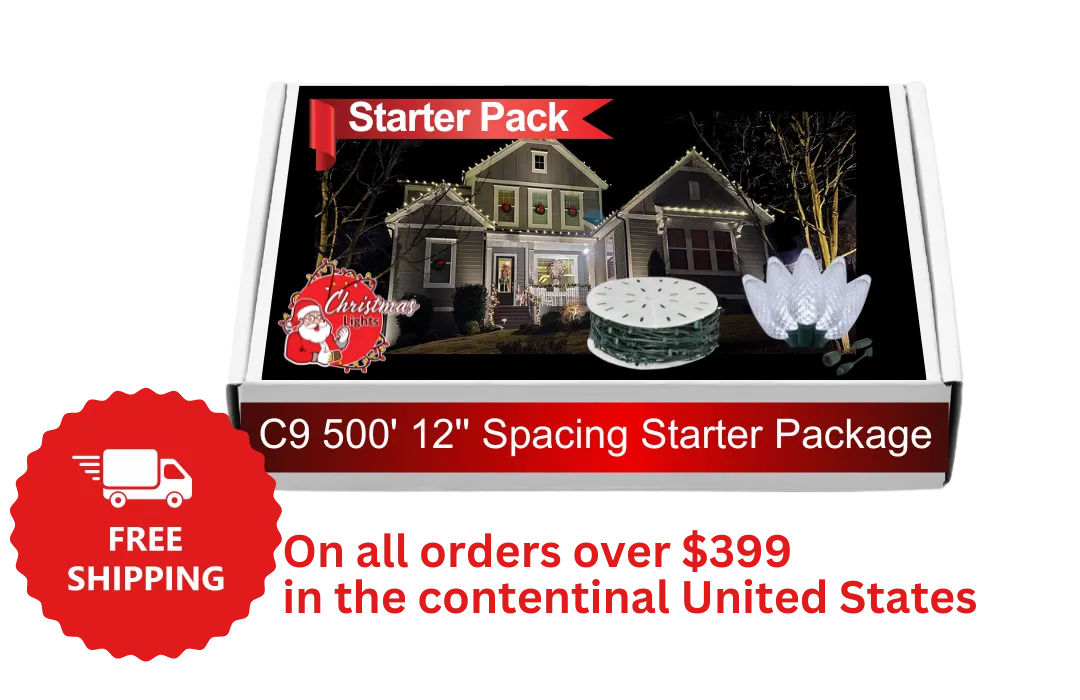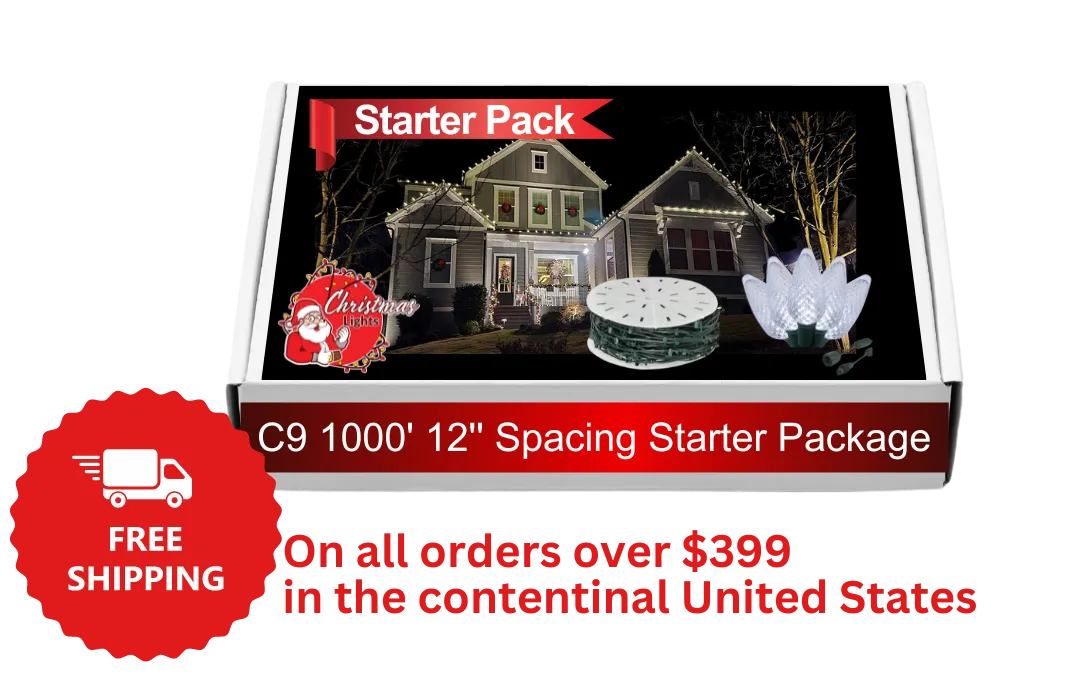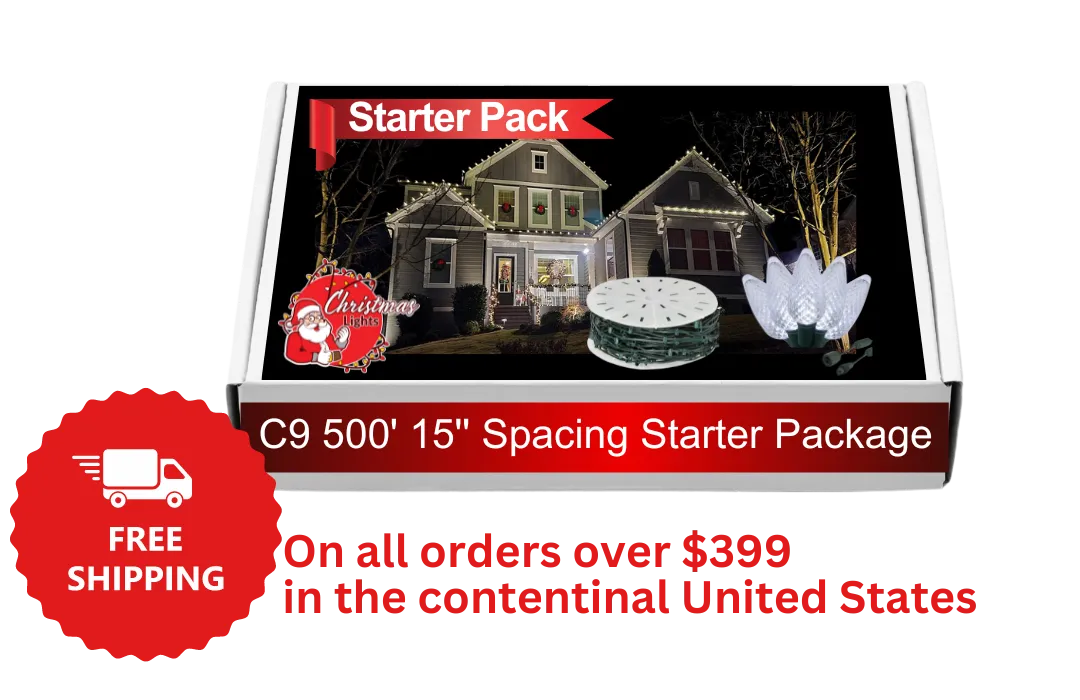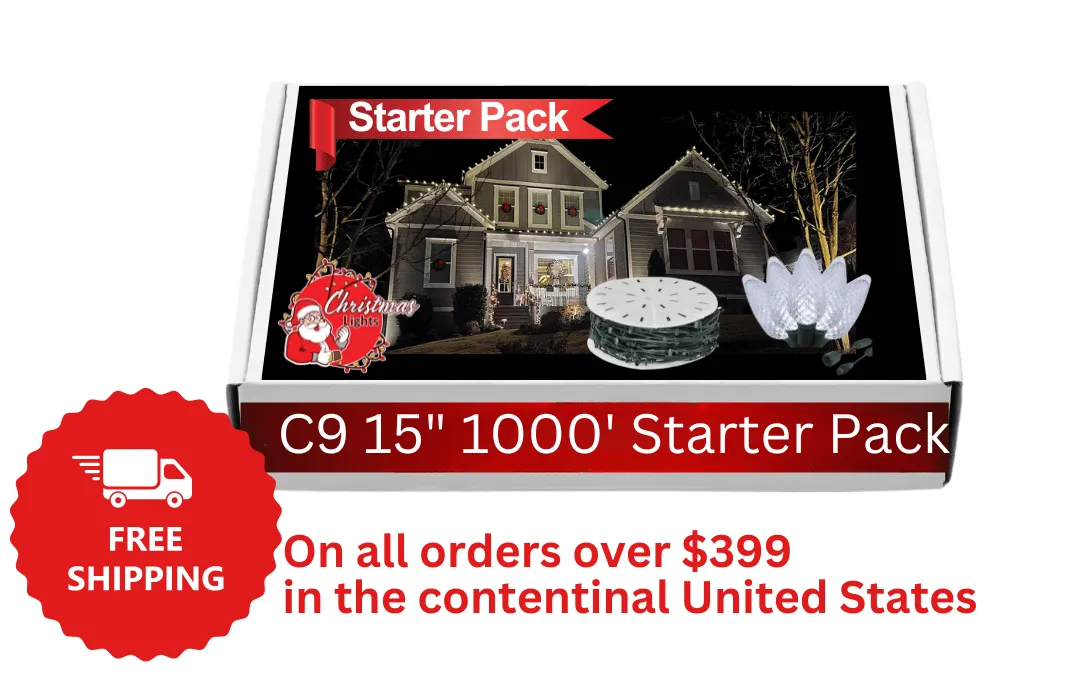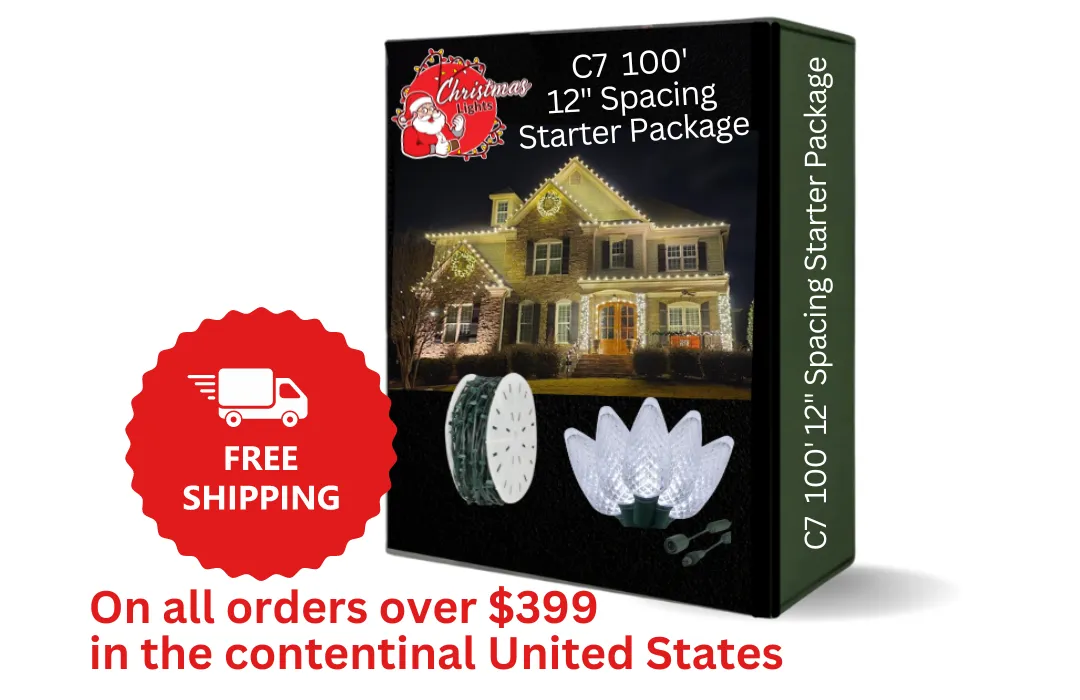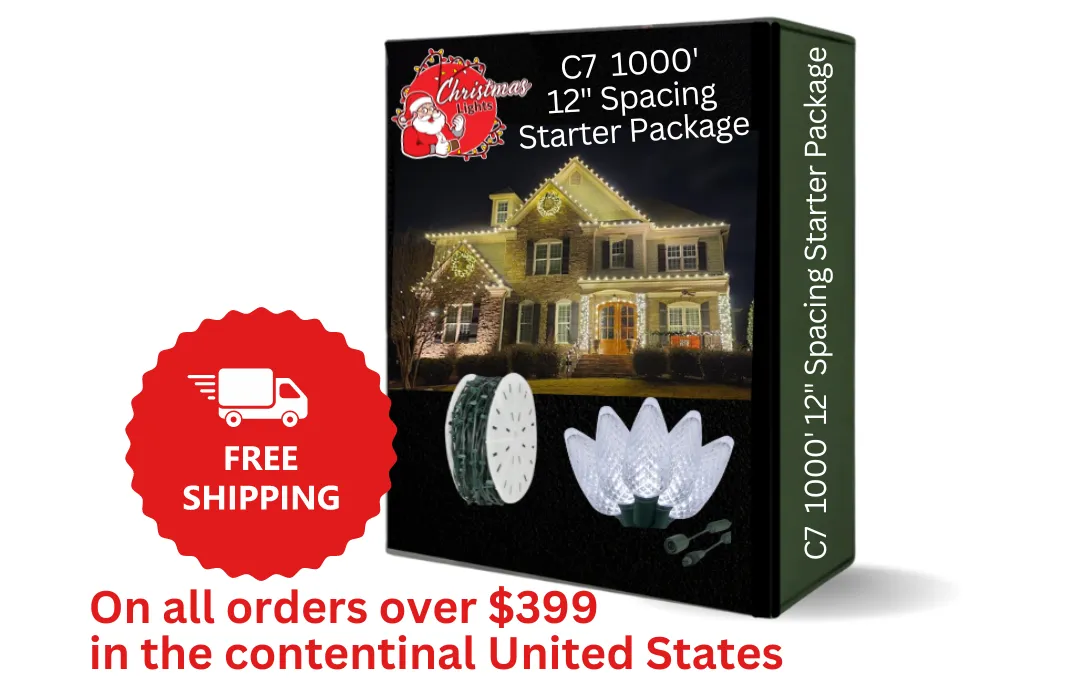Kickstart Your Christmas Lights Installation Business
with Our All-Inclusive Premium Starter Kits
C9 Christmas Lights Starter Packs 12" Spacing
What is included in the Christmas Lights starter pack?
The Christmas Lights starter pack is a comprehensive kit that provides everything you need to get started with your holiday lighting project. It includes all the necessary components, such as clips, male and female plugs, and an extra extension cord.
What specific items are included in the 1000 foot 15" C9 Christmas Lights starter pack?
The 1000 foot starter pack C9 15' spacing package includes the following items:
800 C9 LED Bulbs: These energy-efficient bulbs are the main component of your lighting display, providing bright and vibrant illumination.
800 Best Clips: These clips are designed to securely attach your light strings to various surfaces, ensuring a stable and professional-looking installation.
1000' Green 15" Spacing Socket Spool: This spool contains 1000 feet of green wire with sockets spaced every 15 inches, allowing for even distribution of your C9 bulbs.
250' Green Lamp Cord: This additional lamp cord provides extra length for your lighting setup, enabling you to cover larger areas or create extended displays.
50 Green Male Plugs: These plugs are used to connect your light strings to power sources or to join multiple strings together.
50 Green Female Plugs: These plugs are used to create a seamless connection between your light strings, allowing for a continuous and uninterrupted display.
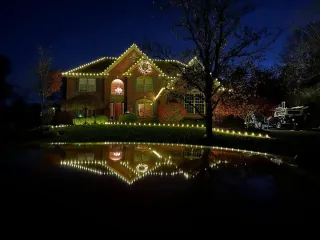
How many houses can I typically light up with a single 1000 foot starter pack?
On average, a 1000 foot starter pack is sufficient to light up approximately 5 to 6 houses, depending on the size and layout of each property.
This estimation is based on the standard components included in the starter pack, such as the 800 C9 LED bulbs and the 1000 feet of socket spool.
However, it's important to keep in mind that every project is unique, and the actual number of houses you can illuminate with a single starter pack may vary.
Factors such as the complexity of the designs, the distance between installation points, and the specific requirements of each client can all impact the coverage of the starter pack.
To ensure a smooth installation process and to accommodate any additional wiring needs, it's always a good idea to have some extra lamp cord on hand for extension purposes.
You may also want to stock up on extra female plugs to facilitate connections between multiple strands of lights or to create custom lengths as needed.
By being prepared with these additional components, you can easily adapt to the specific demands of each project and ensure that you have the flexibility to create stunning and professional-looking lighting displays, regardless of the number of houses you're working on.
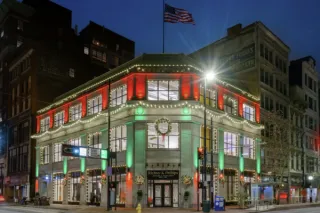
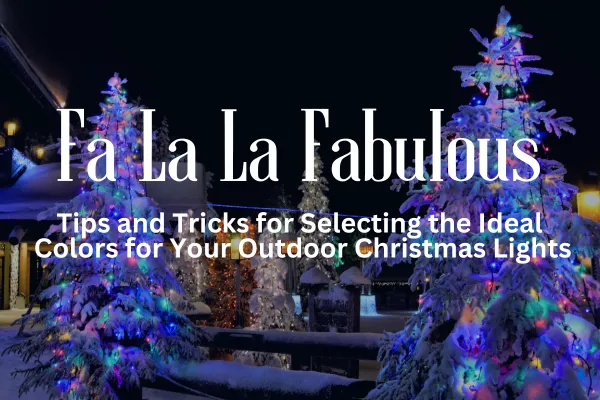
Fa La La Fabulous: Tips and Tricks for Selecting the Ideal Colors for Your Outdoor Christmas Lights
As a professional Christmas light installer, one of the most important aspects of creating a stunning holiday display is choosing the right color scheme. The colors you select can dramatically impact the overall look and feel of a home's exterior during the festive season. In this comprehensive guide, we'll explore the art and science of selecting the perfect color combinations for outdoor Christmas light displays, helping you create magical and memorable installations for your clients.
Understanding the Basics of Color Theory
Before diving into specific color schemes, it's essential to have a solid grasp of color theory. This knowledge will help you make informed decisions and create harmonious displays that truly impress your clients.
The color wheel is a fundamental tool in understanding color relationships. It consists of primary colors (red, blue, and yellow), secondary colors (green, orange, and purple), and tertiary colors (yellow-green, blue-green, blue-purple, red-purple, red-orange, and yellow-orange).
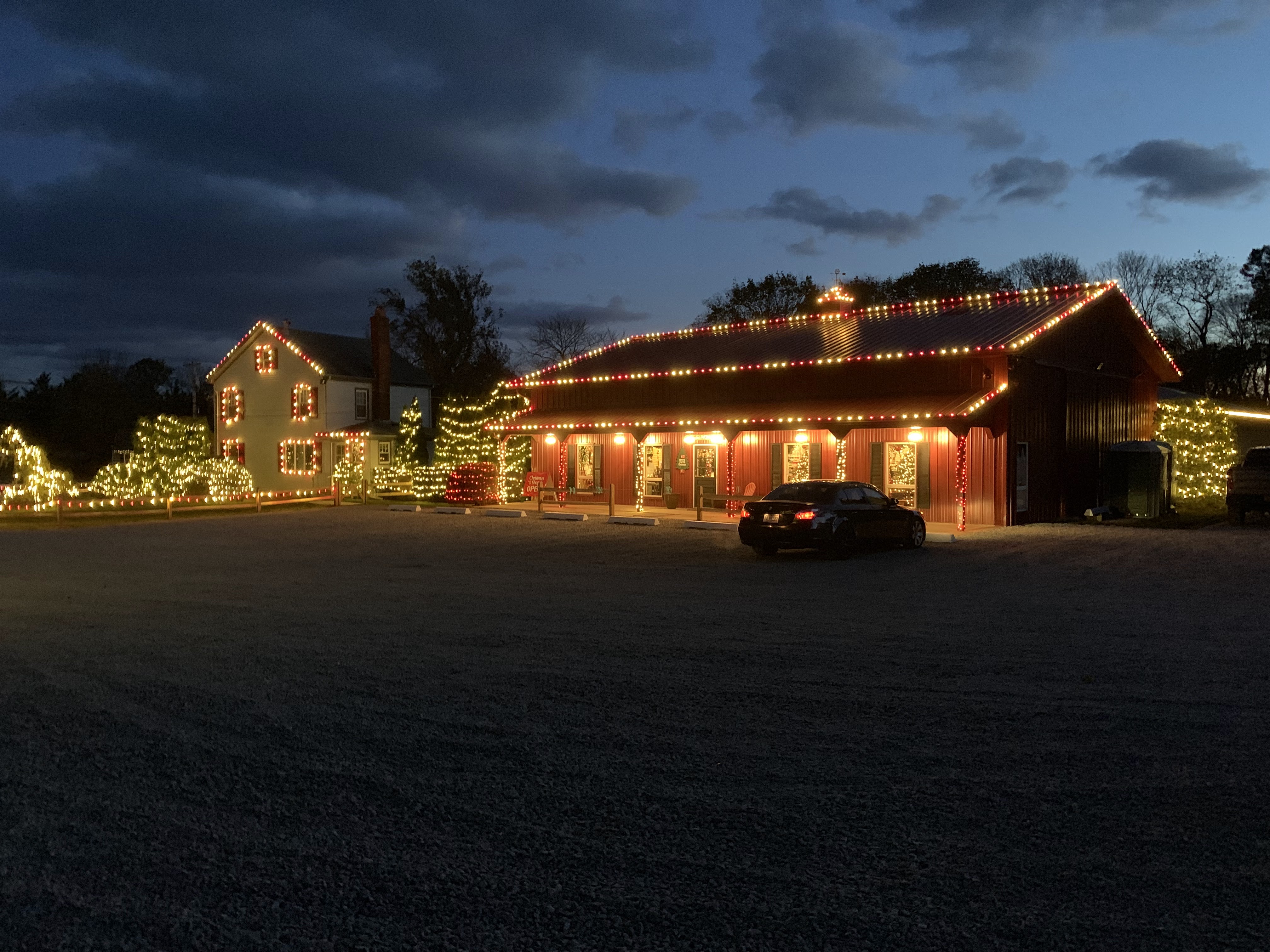
Colors can be categorized as warm (reds, oranges, and yellows) or cool (blues, greens, and purples). Warm colors tend to evoke feelings of coziness and excitement, while cool colors are often associated with calmness and serenity.
When it comes to creating color schemes, there are several classic approaches:
- Complementary: Using colors opposite each other on the color wheel (e.g., red and green)
- Analogous: Using colors adjacent to each other on the color wheel (e.g., blue, blue-green, and green)
- Monochromatic: Using various shades and tints of a single color
Understanding these basic principles will help you create more intentional and visually appealing Christmas light displays.
Factors to Consider When Choosing a Color Scheme
When selecting a color scheme for your clients' outdoor Christmas light displays, there are several important factors to consider:
1. Home's exterior colors and style: The existing colors and architectural style of the home should inform your color choices. For example, a modern home with a neutral exterior might benefit from a sleek, monochromatic display, while a traditional home could look stunning with a classic red and green scheme.
2. Neighborhood aesthetic and HOA guidelines: Be aware of any homeowners' association rules regarding holiday decorations, and consider the overall look of the neighborhood to ensure your display complements rather than clashes with the surroundings.
3. Desired mood and atmosphere: Different color schemes can evoke different emotions. Discuss with your clients what kind of atmosphere they want to create – festive and energetic, calm and elegant, or somewhere in between.
4. Personal preferences and decorating style: Take into account your clients' personal tastes and any existing holiday decorations they plan to use alongside the lights.
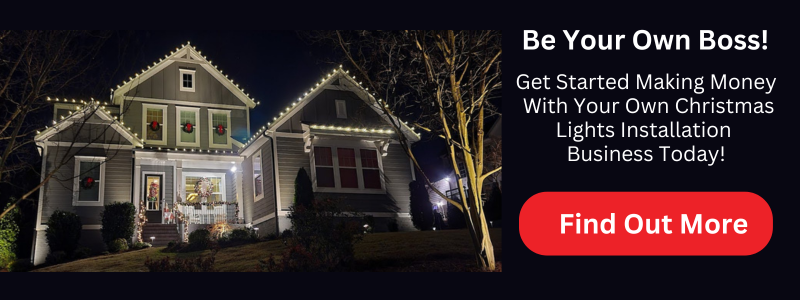
Popular Christmas Light Color Schemes
While there's no one-size-fits-all approach to Christmas light colors, certain schemes have stood the test of time and remain popular choices:
1. Classic red and green: This traditional color combination instantly evokes the Christmas spirit and works well with many home styles.
2. Elegant white and gold: For a sophisticated look, combine warm white lights with gold accents. This scheme is particularly effective on homes with neutral exteriors.
3. Cool blue and white: Create a winter wonderland feel with a combination of blue and white lights. This scheme works well for homes in cooler climates or those with modern exteriors.
4. Festive multi-color: For a playful and energetic display, use a variety of colors. This scheme can be particularly appealing for families with young children.
5. Monochromatic schemes: Using variations of a single color, such as different shades of blue or warm white, can create a cohesive and elegant look.
Tips for Incorporating Multiple Colors
When working with multiple colors in a display, consider the following tips:
1. Choose a dominant color: Select one main color to serve as the foundation of your display, then use other colors as accents.
2. Use the 60-30-10 rule: This interior design principle can be applied to light displays as well. Use your dominant color for about 60% of the display, a secondary color for 30%, and an accent color for the remaining 10%.
3. Repeat colors throughout the display: Create a sense of cohesion by repeating colors in different areas of the home's exterior.
4. Gradually transition between colors: If you're using multiple colors, try to create smooth transitions rather than abrupt changes.
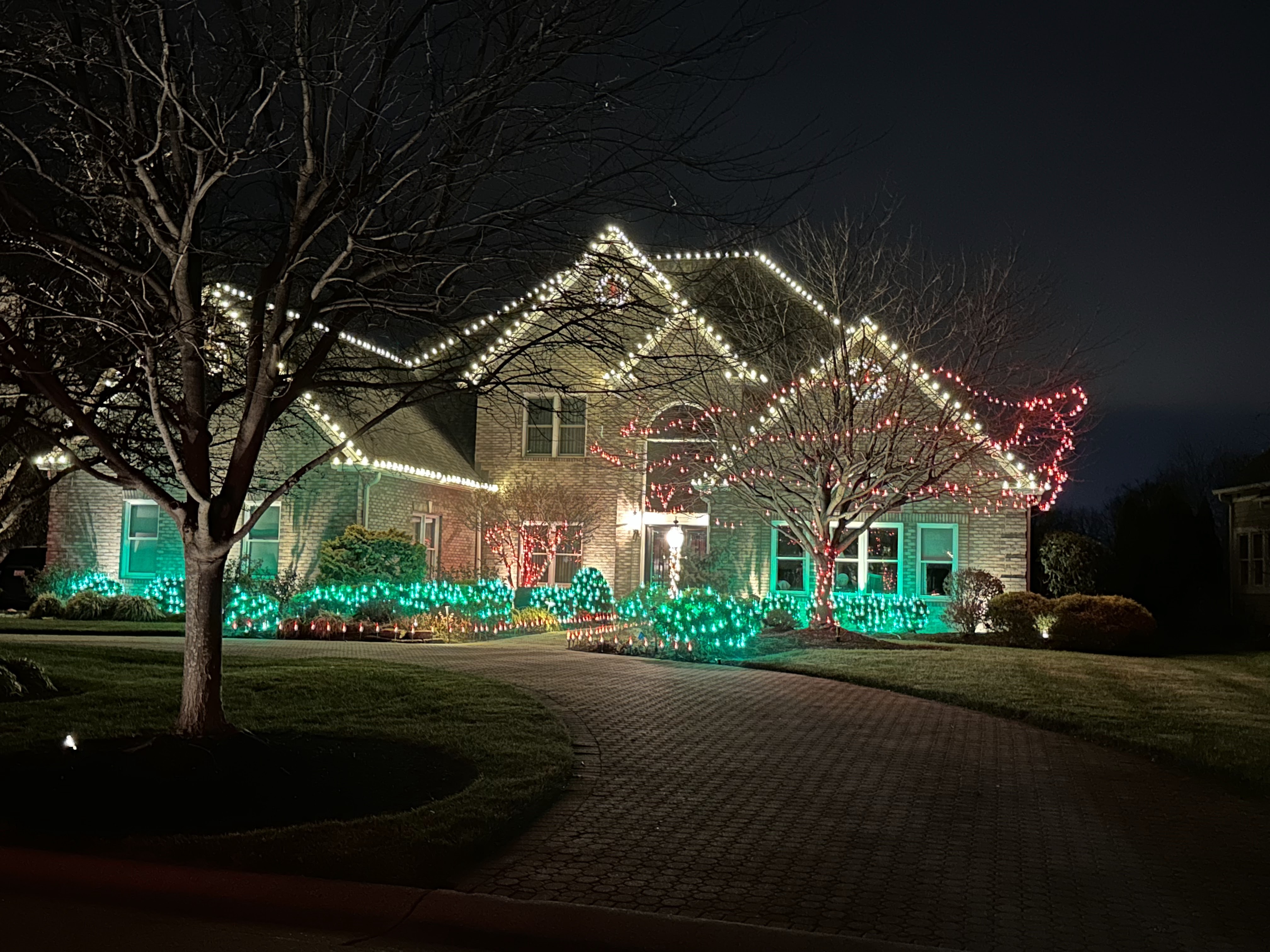
Specialty Lighting Options
In addition to traditional string lights, consider incorporating specialty lighting options to add depth and interest to your displays:
1. Icicle lights: These can create a magical, wintry effect along rooflines and eaves.
2. Net lights: Perfect for quickly and evenly covering bushes and shrubs.
3. Rope lights: Ideal for outlining architectural features or creating custom shapes and designs.
4. Projector lights: These can add dynamic, moving elements to a display without the need for complex installations.
Coordinating with Other Decorations
For a truly cohesive look, consider how the Christmas lights will interact with other decorations:
1. Match light colors to wreaths, garlands, and ribbons for a coordinated appearance.
2. Use colored ornaments in outdoor trees and planters to complement the light display.
3. Incorporate colored yard décor, such as illuminated reindeer or candy canes, that align with your chosen color scheme.
4. Create a connection between outdoor and indoor decorations by using similar color schemes for both.
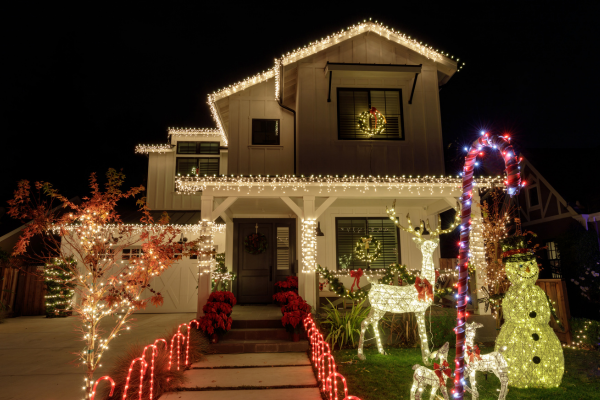
Lighting Techniques for Different Areas of the Home
Different areas of a home's exterior may require different lighting approaches:
1. Roofline and gutter lighting: Use evenly spaced lights to highlight the home's silhouette. C9 bulbs are often a good choice for this area.
2. Window and door frame lighting: Outline these features with smaller lights, such as mini lights or LED icicle lights.
3. Column and post wrap lighting: Spiral lights around columns and posts for a festive effect.
4. Tree and shrub lighting: Use net lights or strategically placed string lights to illuminate landscaping.
5. Walkway and driveway lighting: Consider using stake lights or rope lights to guide visitors safely to the entrance.
Energy Efficiency and Maintenance
As a professional installer, it's important to consider the long-term efficiency and maintenance of your light displays:

1. Choose LED lights: These use significantly less energy than traditional incandescent bulbs and have a much longer lifespan.
2. Use timers and smart plugs: Help your clients save energy by setting up automatic on/off schedules for their displays.
3. Proper storage and organization: Advise your clients on the best ways to store their lights to prevent damage and tangling.
4. Regular inspection and maintenance: Offer a service to check and replace any damaged bulbs or cords throughout the holiday season.
Choosing the right color scheme for outdoor Christmas light displays is both an art and a science. By understanding color theory, considering important factors like home style and client preferences, and implementing creative lighting techniques, you can create stunning displays that will delight your clients and their neighbors alike.
Remember, there's no one "perfect" color scheme – the best choice will depend on the specific circumstances of each project. Don't be afraid to experiment with different combinations and techniques to find what works best for each unique situation.
As a professional Christmas light installer, your expertise in creating beautiful, harmonious displays will bring joy and festivity to homes throughout the holiday season. By mastering the art of color selection and implementation, you'll set yourself apart in the industry and create magical experiences for your clients year after year.
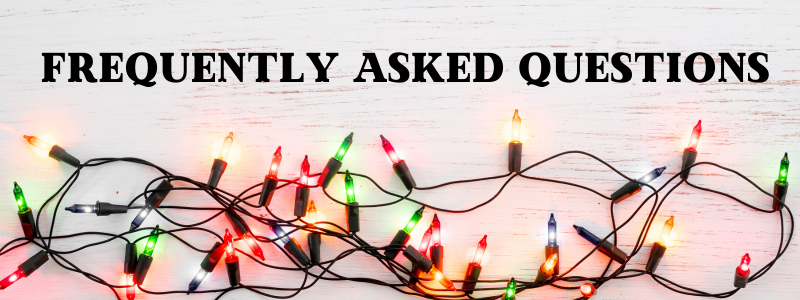
1. Q: What are the basic color schemes used in Christmas light displays?
A: The basic color schemes include complementary (opposite colors on the color wheel), analogous (adjacent colors), and monochromatic (various shades of one color).
2. Q: How does a home's exterior color affect the choice of Christmas light colors?
A: The home's exterior colors should inform your light color choices to ensure a harmonious look. For example, a neutral exterior might pair well with a monochromatic display.
3. Q: What is the 60-30-10 rule in Christmas light color schemes?
A: The 60-30-10 rule suggests using 60% of your dominant color, 30% of a secondary color, and 10% of an accent color in your display.
4. Q: How can I create a cohesive look with multiple colors?
A: To create a cohesive look with multiple colors, choose a dominant color, repeat colors throughout the display, and create gradual transitions between different hues.
5. Q: What are some popular Christmas light color schemes?
A: Popular schemes include classic red and green, elegant white and gold, cool blue and white, festive multi-color, and monochromatic designs.
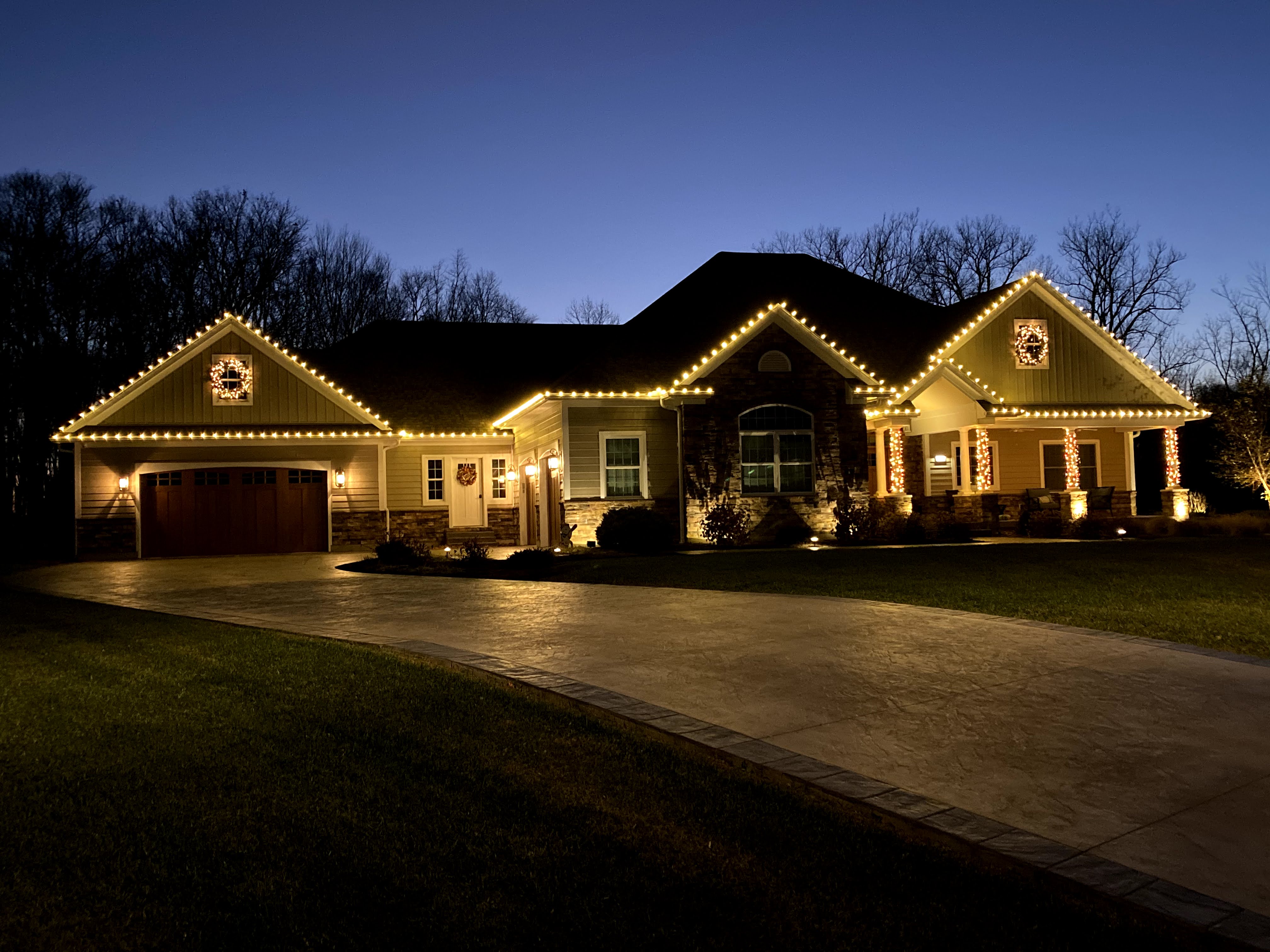
6. Q: How can I incorporate specialty lighting options into a display?
A: Specialty lighting options like icicle lights, net lights, rope lights, and projector lights can add depth and interest to your display when used strategically.
7. Q: Why is it important to consider energy efficiency in Christmas light displays?
A: Energy-efficient options like LED lights can significantly reduce power consumption and costs, while also lasting longer than traditional incandescent bulbs.
8. Q: How can I ensure my light display complements other outdoor decorations?
A: Coordinate your light colors with other decorations like wreaths, garlands, and yard décor to create a cohesive overall look.
9. Q: What factors should I consider when choosing a color scheme for a client?
A: Consider the home's style, neighborhood aesthetic, HOA guidelines, desired mood, and the client's personal preferences when choosing a color scheme.
10. Q: How can different areas of a home be lit effectively?
A: Different areas require different approaches: use evenly spaced lights for rooflines, outline windows and doors with smaller lights, wrap columns and posts, and use net lights for trees and shrubs.


